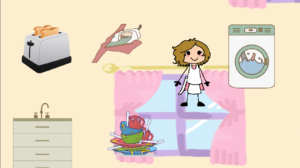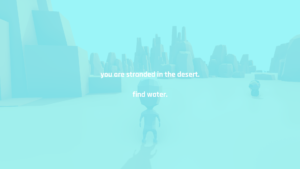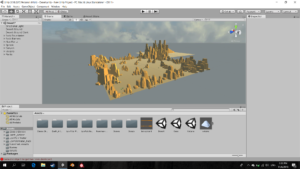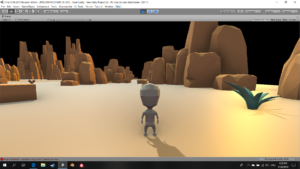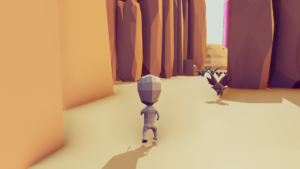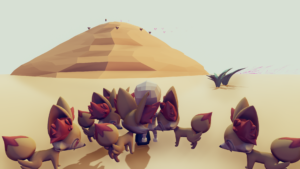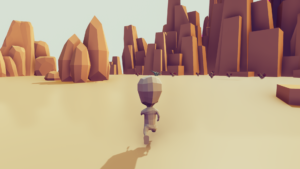A colorful playground that grows with the imagination of individuals. Tangle is a welcoming space that proves what could be accomplished with a bundle of a thread. There are multiple poles on a stage stranded with colorful threads around, swarmed by their creators. People are having a good time with the company of music. The participants are mostly children who are observed by their worried parents for in case something goes wrong. Each child is given a bundle of a thread which they go around playing while tangling it around however they wish. The tangling usually starts by creating a knot on a random spot such as a pole, or another already existing thread. Then with the bundle of thread at hand, the navigation starts around the space. The thread travels twisting around the space on the direction the participant wishes. As a result, another thread takes its place next to many others enlarging the space a little bit more. Once the work with the thread is done, the participant starts playing around the space, socially interacting with the other participants. There is a constant movement in the space, a constant creation. Such a mobility evolves the space into a more customized one by time. There are performers leading the flow of this growth. They are interacting with the participants to aid them to express themselves. Space is the fruit of expression, in this sense, it exhibits artistic value.
There is a deeper meaning behind the play. Space is not the result of only one individual’s ambition and decisions. The consequentiality in this regard cannot be credited to one person. It is the result of a group play, each individual participated. This, however, is different than multiple people painting together an art piece because the possible actions are much more random and the boundaries are much few. When a group is painting together it is much simpler for one to grasp what the other is doing, there is much less randomness involved. There is one dimension missing and it is much simpler to tell when the piece is complete which part of it was painted by whom. Another difference with the painting would be the aspect of interaction. The work of a child is constantly affected by one another. The way the thread will be incremented into the already existing art piece will be affected by the scattering of the children, the density of the already existing threads, the relative position of the children who like each other and who dislike each other. The social aspect of this play will greatly influence the art itself. A child who is going around with his thread will see his friend and change his direction, approaching towards him. On the contrary, he could get in a small argument with another child and move away from her. What makes Tangle an art piece is the fact that the space is molded by perpetual social interactions. When observed as a whole, Tangle is the art of a group but each step of this art is anonymously made.
The anonymity of the children could be challenged by a simple question. Once done with tangling the thread and lost track of it, could any of the children exactly tell which thread belonged to them? The answer to this question reveals an assertion. The value given to their own contribution is dominated by their willingness to be a part of the group. This assertion is helpful in explaining the anonymity. The condition of anonymity is the result of the attitude the children have towards the space. They are not there to create art, they are there to play and have fun. This makes them more unaware of their navigation through the space so their lack of artistic intent creates a more artistic space. That is because space grows more in the direction of social interactions the children are having rather than an artistic purpose. The performers have a vital role in such a shaping of the space because of their reserved social role as guides. The performers have direct control over what part of the space will be populated. The scattering of the children is greatly influenced by the actions of the performers. They can drag the attention to themselves with an interesting proposition such as let us pretend this thread is a sea. They can minorly affect the perceptions of the children of the space via inventing mini-games inside the already existing game. They can say that the floor is lava and the navigation of the children will be completely different. Children will try climbing to the thread not to step to the lava. The actions of the performers in this regard have an influence on the finalized art piece that is the space with colorful threads lying around.
In terms of the experience, Tangle provides an opportunity for trading ideas and creations. For a child, Tangle space is different than a basic playground because it was partially built by him. On the contrary, it optionally offers the exact opposite too! As a play, Tangle achieves to create a feeling of freedom to contribute without being judged. There is a form of relief to know that no one could ever tell which part of the space was crafted by you if you do not want to share that information. A participant could agree to move a thread in a planned fashion in company with another participant or he could do it alone in peace. In this way, the imagination of the participants, mostly children as mentioned before, are not limited with their social phobias or introvert characters. There is a room for play for everyone.
Tangle is successful in bringing out the creative and expressive sides of its participants. I can confirm this as a participant myself. The positive aspect of this expression is that it is unconscious and totally the result of the participants’ social interaction. Each incrementation is unique, there are no two threads that take the same path. Overall, I believe Tangle manages to create a successful play environment paved with social interaction, guidance, and a little bit imagination.
Dogukan Avci
